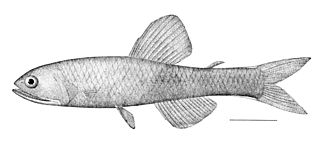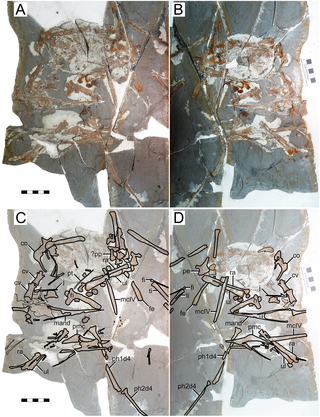
Fauna is all of the animal life present in a particular region or time. The corresponding terms for plants and fungi are flora and funga, respectively. Flora, fauna, funga and other forms of life are collectively referred to as biota. Zoologists and paleontologists use fauna to refer to a typical collection of animals found in a specific time or place, e.g. the "Sonoran Desert fauna" or the "Burgess Shale fauna". Paleontologists sometimes refer to a sequence of faunal stages, which is a series of rocks all containing similar fossils. The study of animals of a particular region is called faunistics.
Darwinneon is a monotypic genus of jumping spiders containing the single species, Darwinneon crypticus. It was first described by B. Cutler in 1971, and is only found on the Galápagos Islands. The name is a combination of the Neon and Charles Darwin. Crypticus means "hidden" in Latin.

Lampanyctus is a genus of lanternfishes.

Eopteranodon is a genus of tapejarid pterosaur from the Aptian-age Lower Cretaceous Yixian Formation of Beipiao City, Liaoning, China. The genus was named in 2005 by paleontologists Lü Junchang and Zhang Xingliao. The type species is Eopteranodon lii. A second species, E. yixianensis, was named in 2023, but its validity has been questioned.

Sinopterus is a genus of tapejarid pterodactyloid pterosaur from the Aptian-age Lower Cretaceous Jiufotang Formation of Chaoyang, Liaoning, China. It was first described and named by Wang Xiaolin and Zhou Zhonghe. Historically, there were multiple species attributed to the genus although only one is considered to be valid. Sinopterus is known for its proportionally large skull, which has a birdlike pointed beak, a long bony crest that starts with a tall premaxilla and goes back along the middle of the skull to form a point overhanging the rear of the skull, and its lack of teeth.

Madtoms are freshwater catfishes of the genus Noturus of the family Ictaluridae. It is the most species-rich genus of catfish in North America, native to the central and eastern United States, and adjacent parts of Canada. Their fin spines contain a mild venom with a sting comparable to that of a honey bee.
Fauna Europaea is a database of the scientific names and distribution of all living multicellular European land and fresh-water animals. It serves as a standard taxonomic source for animal taxonomy within the Pan-European Species directories Infrastructure (PESI). As of June 2020, Fauna Europaea reported that their database contained 235,708 taxon names and 173,654 species names.

Nemicolopterus is a dubious genus of tapejaromorph pterosaur, based on a very small specimen described as the smallest known "adult" pterosaur to date. It lived in the Jehol Biota 120 million years ago.

Escalera's bat is a European bat in the genus Myotis, found in Spain, Portugal, and far southern France.

Oregus is a genus of beetles in the family Carabidae that is endemic to New Zealand. A 2003 taxonomic revision of the group using both morphological and DNA characters concluded that it contained four species, and identified new species from Marlborough and North Canterbury. The current species list is:

Haplanister is a genus of carabids in the beetle family Carabidae. This genus has a single species, Haplanister crypticus, found in New Zealand.

The chucky madtom is a critically endangered freshwater fish endemic to the U.S. state of Tennessee.

Noturus fasciatus is a rare freshwater fish native to the U.S. state of Tennessee. It was first described as a species separate from Noturus crypticus in 2005. It is restricted to the Duck River system and is also found in two minor tributaries on the lower section of the Tennessee River. This species dwells in small to medium-sized streams where they can be found under gravel, rubble, and slab rock. They feed mostly on insects such as: stone, cattus and mayfly larvae.

Euodynerus crypticus is a species of stinging wasp in the family Vespidae.

Lasius crypticus is a species of ant in the family Formicidae.

The cryptic myotis is a European vespertilionid bat. It is a member of the Natterer's bat species complex, and is also the closest living relative of M. nattereri.
The Zenati myotis is a rare species of mouse-eared bat that is restricted to North Africa. It is very rare in Morocco, being restricted to just four localities ranging from the Rif to the Atlas Mountains. Aside from Morocco, it is only known from three populations in northern Algeria, although it is possible that populations may exist in Tunisia. There are two genetically distinct haplogroups in the Atlas Mountains that could be further considered distinct subpopulations. It is a member of the Natterer's bat species complex and closely resembles the cryptic myotis, though its closest relative is Escalera's bat . 300,
Tribalus is a genus of beetles belonging to the family Histeridae. There are seven species occurring in the western Palaearctic. Apart from that, most species are distributed throughout Oriental and African regions.
Polynoncus crypticus is a species of hide beetle in the family Trogidae, being found in Chile and discovered in 2019.














